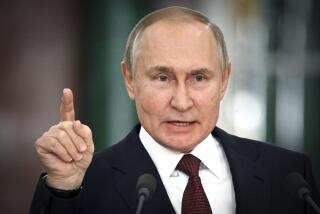Moscow Misses Its Economic Growth Target
- Share via
MOSCOW — The Soviet economy, while growing 2.5% in a year marked by stock market crashes elsewhere and uncertain oil prices, failed to meet its targeted growth rate of 4.1% in 1987, according to year-end statistics published Sunday in the Communist Party newspaper Pravda.
Disclosure of the below-target growth rates followed a series of reports recently warning that up to 16 million Soviets could lose their jobs in the next few years, and plans have been drawn to ease the social burden of unemployment on the state and the individual.
The statistics showed 2.4 million Soviets lost their jobs in 1987 due to mechanization and a government-sanctioned drive against low worker productivity.
The size of the Soviet work force was listed at 131.3 million, and Pravda said it was the first time “in many years” that a rise in industrial output was due solely to increased worker productivity.
The average monthly wage of the Soviet industrial and office worker rose slightly from $333.20 to $341.70, while farm wages went up $6.80 to $283.90, reflecting Gorbachev’s policy that wages should be tied directly to productivity.
‘More Accurate Indicator’
Western diplomats said the statistics probably reflect “a more accurate indicator of true performance” compared to previous year-end statistics that normally boast of dramatic but artificial world pace-setting growth rates.
“We have to look more carefully at the statistics, but at first glance they appear to show an adequate growth rate for the economy,” one diplomat said.
He said the economic targets may have been set too high, or if they were achievable “the reorganization in the economy is causing confusion and hurting performance.”
“I don’t see this as a crisis situation for (Soviet leader Mikhail S.) Gorbachev. With the exception of the consumer goods industry and machine building it looks like it was an acceptable year overall. Gorbachev himself warned that it might get worse before it gets better,” the diplomat said.
Exceedingly poor performances were recorded in the engineering and machine-building sector, consumer goods industry and quality control--areas singled out by Gorbachev as needing improvement.
Limited Private Enterprise
In 1987, the Soviet Union allowed the introduction of limited private enterprise in direct competition with state-run industries in the light manufacturing and service sectors.
Beginning this year, 60% of industry is to change to a profit-loss system, introducing for the first time the possibility of state firms going bankrupt.
The government plans to cut back on subsidies to non-profitable, non-essential firms.
Foreign trade fell 2.2% to $217.6 billion in 1987. A lower volume of trade with capitalist countries accounted for most of the downturn, according to the State Committee for Statistics.
The slowdown reflected Soviet concern over unstable oil prices and the dramatic decline in the value of the dollar, the currency used to price oil. The Kremlin earns up to 60% of its foreign exchange on oil exports.
The production of consumer goods fell 1.1% short of its target growth rate of 4.5%.
Despite a reasonably good grain harvest in 1987 of 211.3 million tons, marginally up over 1986, the increase of 0.2% was far below planned growth of 2.2%.
More to Read
Sign up for Essential California
The most important California stories and recommendations in your inbox every morning.
You may occasionally receive promotional content from the Los Angeles Times.








